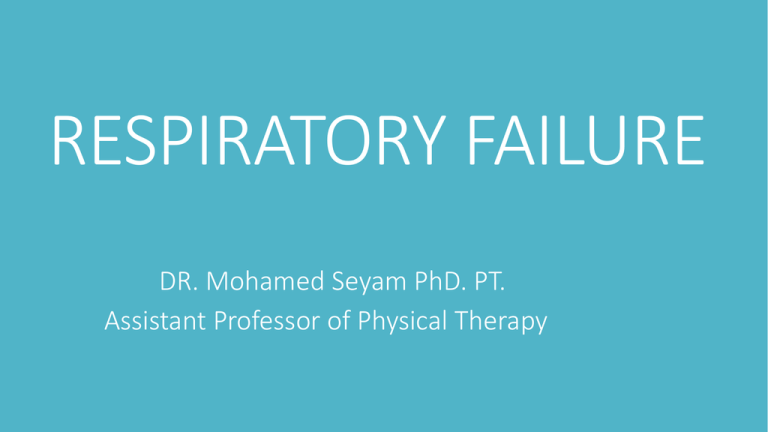respiratory 9
advertisement

RESPIRATORY FAILURE DR. Mohamed Seyam PhD. PT. Assistant Professor of Physical Therapy RESPIRATORY FAILURE Failure of the respiratory system to provide adequate gas exchange for metabolic requirements is known as respiratory failure (RF). This is divided into the following: I. Type I Respiratory Failure II. Type II Respiratory Failure RESPIRATORY FAILURE The process of respiration includes more than gas exchange in the lung, but the term respiratory failure is reserved for disorders that result in a disturbance of arterial blood gases only. Respiratory insufficiency occurs when adequate gas exchange is maintained but at great cost to the breathing mechanism. It is sometimes a sign of impending respiratory failure ventilation/perfusion ratio (or V/Q ratio) The ventilation/perfusion ratio (or V/Q ratio) is a measurement used to assess the efficiency and adequacy of the matching of two variables: "V" – ventilation – the air that reaches the alveoli "Q" – perfusion – the blood that reaches the alveoli VQ Ratio can defined as: the ratio of the amount of air reaching the alveoli to the amount of blood reaching the alveoli. These two variables, V & Q, constitute the main determinants of the blood oxygen (O2) and carbon dioxide (CO2) concentration. The V/Q ratio can be measured with a ventilation/perfusion scan. Extreme alterations of V/Q An area with perfusion but no ventilation (and thus a V/Q of zero) is termed "shunt." An area with ventilation but no perfusion (and thus a V/Q undefined though approaching infinity) is termed dead Pathophysiology A lower V/Q ratio impairs pulmonary gas exchange and is a cause of low arterial partial pressure of oxygen (paO2). Excretion of carbon dioxide is also impaired, but a rise in the arterial partial pressure of carbon dioxide (paCO2) is very uncommon because this leads to respiratory stimulation and the resultant increase in alveolar ventilation returns paCO2 to within the normal range. These abnormal phenomena are usually seen in: chronic bronchitis, asthma, hepatopulmonary syndrome, and acute pulmonary edema. A high V/Q ratio decreases PACO2 and increases PAO2. This finding is typically associated with pulmonary embolism (where blood circulation is impaired by an embolus). Ventilation is wasted, as it fails to oxygenate any blood. A high V/Q can also be observed in emphysema as a maladaptive ventilatory overwork of the undamaged lung parenchyma. Arterial pO2 will decrease as a result due to lack of reoxygenation. Classification of Respiratory Failure Type I Type II Type I Respiratory Failure RESPIRATORY FAILURE Type I (hypoxemic) is failed oxygenation, represented by Pa02 below 60 mmHg. It is caused by failure of the gas exchanging function of the respiratory system. It can be acute (e.g. pneumonia) or chronic (e.g. pink puffer type of COPD). Type II Respiratory Failure Respiratory failure type II (hypercapnic) is failed ventilation, represented by PaC02 over 45 mmHg and hypoxemia. It is caused by 1. failure of the respiratory pump 2. can be acute (e.g. severe acute asthma) 3. chronic (severe restrictive disease). Type II RF is also known as ventilatory failure. It is a clinical manifestation of impaired central respiratory control, muscle weakness or fatigue, reflected by respiratory muscle strength falling below 30% of normal.





